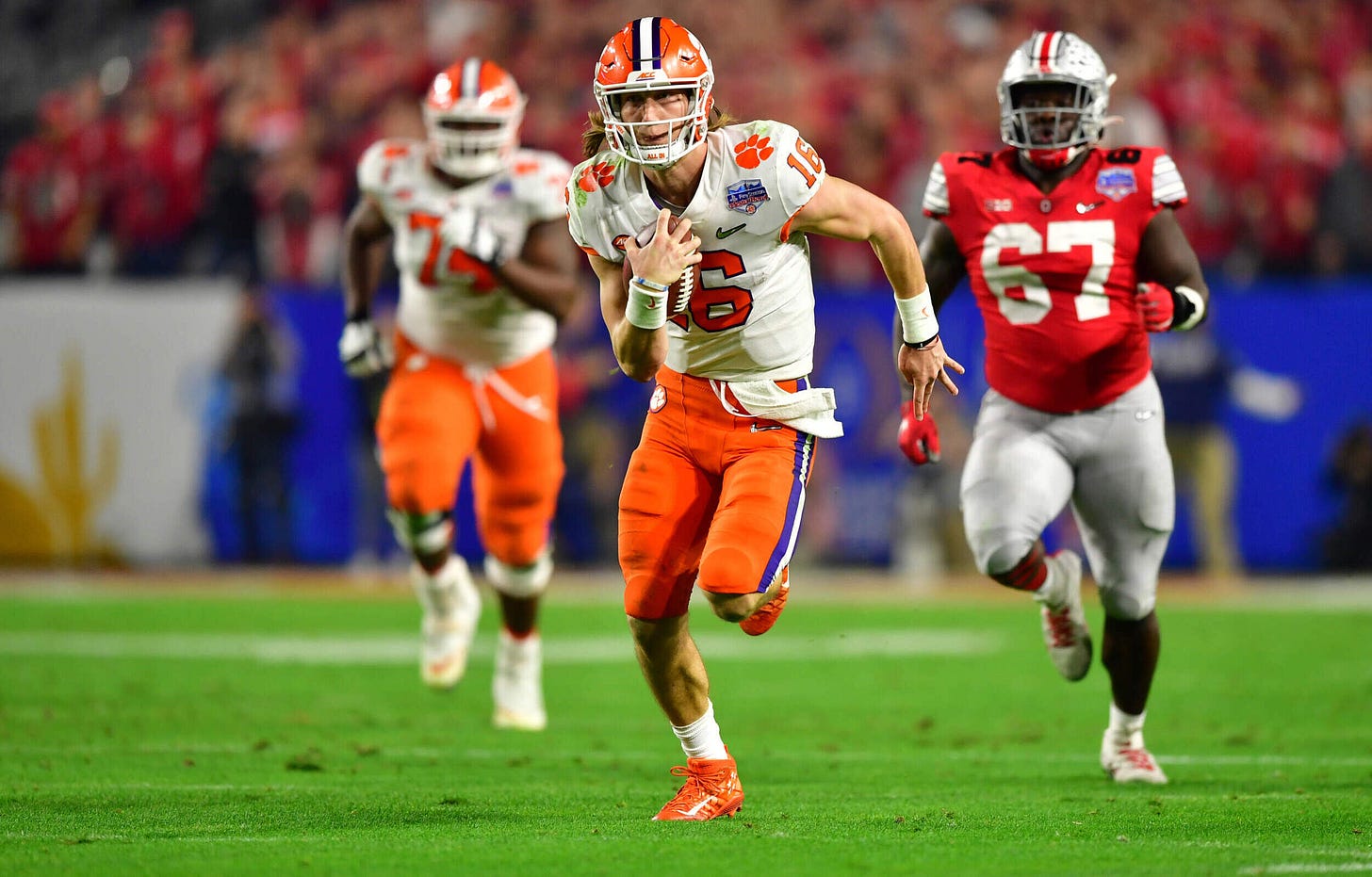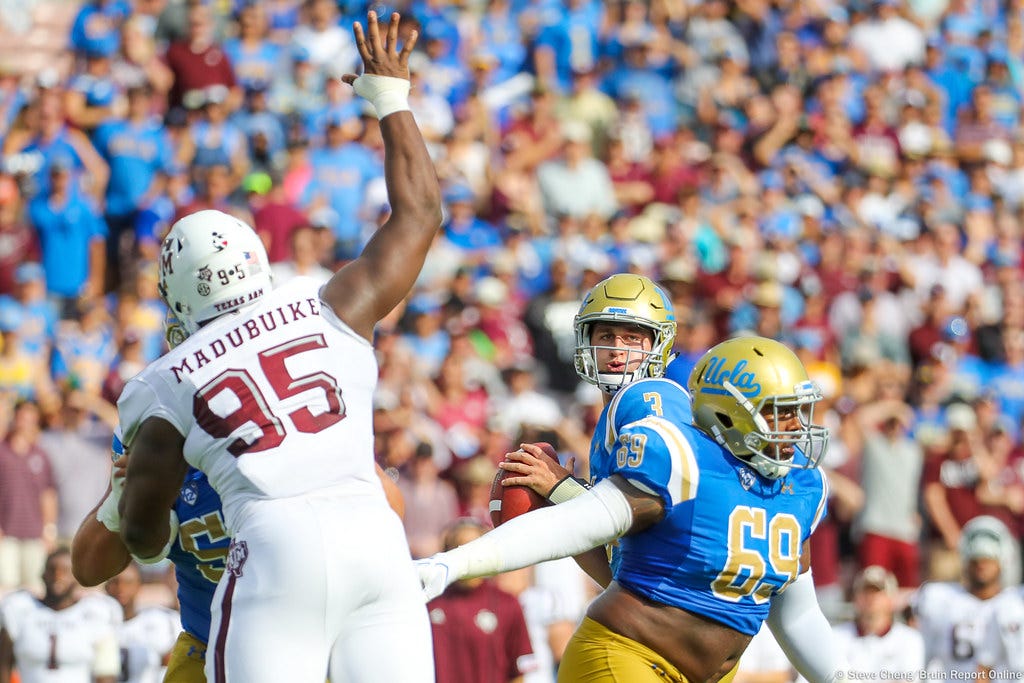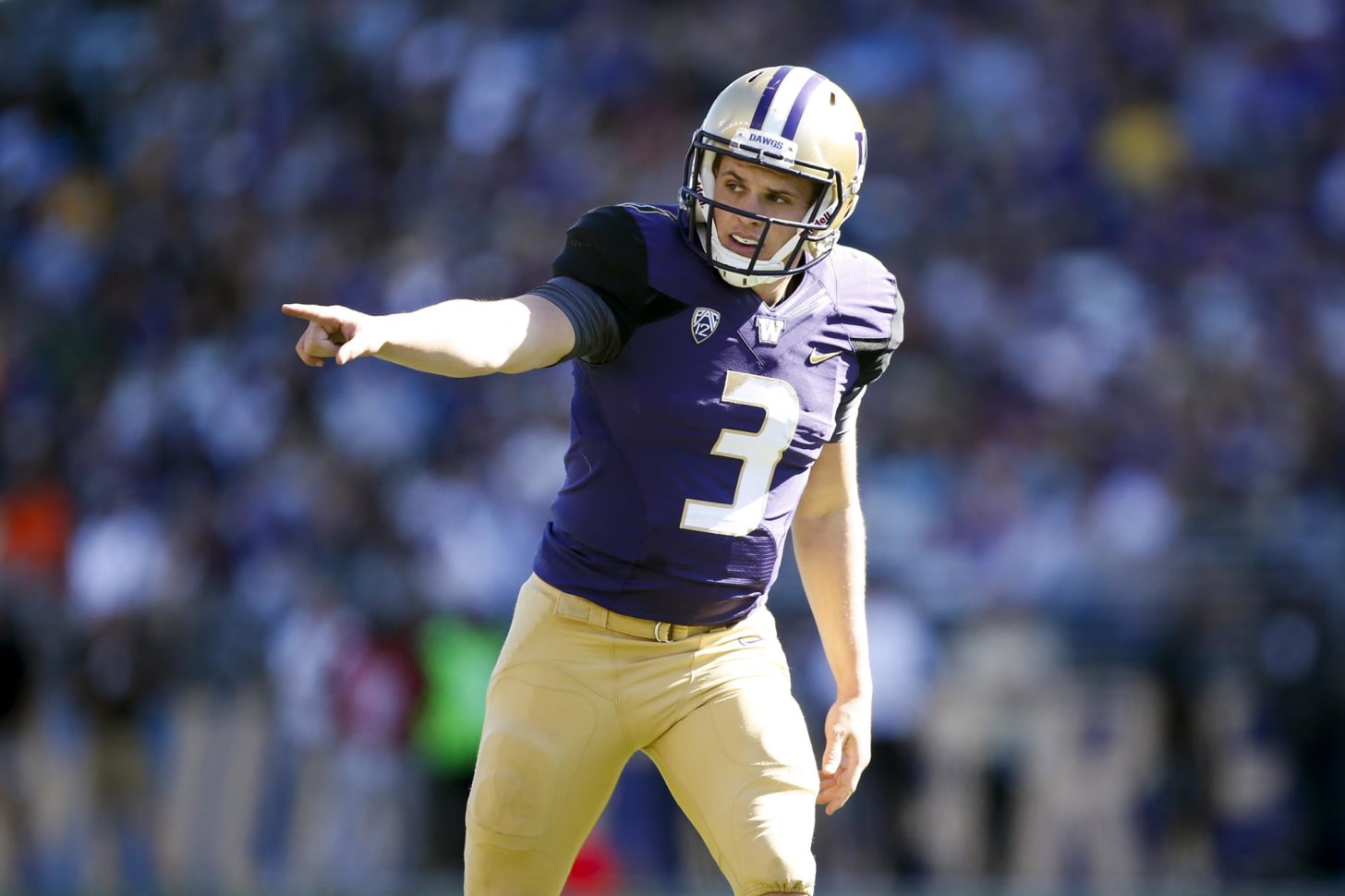Does This Ever Work? Part 2
Continuing to name some college quarterbacks from the mid- to late-2010s
This is Part 2 in a three-part series examining the success of five-star quarterbacks who started in their freshmen seasons. The other two parts can be found here: Part 1 and Part 3.
Welcome back to Black 41 Flash Reverse. This is Part 2 in a deep dive into the recent history of five-star true freshman quarterbacks ahead of Dylan Raiola’s likely debut for Nebraska this season. Part 1, which covers the 2009-14 recruiting classes and offers a general explanation/methodology, can be found at this link. Part 3, which covers the 2019-23 classes and has some general takeaways/conclusions about what makes these situations succeed or fail, will be out later this week.
Ready to continue Remembering Some Guys? Let’s get back to it:
2015
Josh Rosen, UCLA
Recruiting Profile
We’re again kicking off the list with a California uber-prospect! Much like Matt Barkley, Rosen was considered a generational recruit out of a Los Angeles powerhouse prep program and was considered the consensus No. 1 overall recruit in the country through much of the 2015 class’ early cycle. He fell off a bit at the end but still finished as a consensus high five star and the top QB per both services. He was the No. 2 player overall per Rivals and No. 15 player overall on 24/7. Both his initial standing and eventual landing spot as a recruit profile similarly to Raiola, who finished No. 2 overall per Rivals and No. 7 overall per 24/7. Rosen took all of his visits about nine months before Signing Day and committed to nearby UCLA shortly after. He enrolled early for spring practice and took a majority of the reps as the starter for the Bruins in the spring period.
Rosen’s breakdown as a prep prospect is a little lower on Rosen’s arm talent and he has a slighter frame than Raiola, but the profile has higher marks for Rosen’s athleticism (4.7 40-yard-dash) and scrambling ability.
Freshman Performance
UCLA had an opening at quarterback after Brett Hundley left early for the NFL, and Rosen got a jump on the job by enrolling in January. He was consistently praised as the Bruins’ best quarterback through spring practice and summer workouts. He was officially named the starter late in fall camp over veteran Jerry Neuheisel.
Rosen’s debut went about as outstanding as one can go: UCLA trusted him to rip 35 passes, and he completed 28 of them for 351 yards (one of the incompletions was a drop) with no turnover-worthy plays and only one of 12 pressures against him turning into a sack. That one game thrust the true freshman into immediate Heisman contention.
The rest of the year would be more of a mixed bag. His next two games were struggles, with his adjusted completion percentage falling under 60%. In one of those games, he threw for only 106 yards and had three picks in a near-loss to BYU. He opened conference play with a couple productive, if inefficient, performances, both losses, then went supernova again in a win against No. 20 Cal: 34-for-47 for 399 yards and three scores with no picks and only one sack on 49 dropbacks. That game against the Golden Bears kicked off a stretch of strong play to close the year; he would average over 296 passing yards per game over his last six starts with only 12 turnover worthy plays in 256 dropbacks. UCLA went 4-2 over that stretch, which included a win over No. 13 Utah, and make a bowl. The Bruins would close the season, though, with a loss to a 5-7 Nebraska team in the Foster Farms Bowl,1 a game in which Rosen threw for 319 yards but had two turnovers.
Overall, Rosen had the most statistically prolific passing freshman year of anyone on this list. He finished with over 3,300 passing yards and topped 20 total touchdowns. He was also probably the highest usage player as a freshman. He had 516 total dropbacks and attempted 487 total passes in his first year; UCLA would run under 400 designed rush plays in that season. The next closest player on this list only had 424 dropbacks and 397 attempts. While he didn’t do a great job turning that usage into efficient yardage, Rosen would do a remarkable job of taking care of the ball while lifting that heavy of an offense’s load. He would commit a turnover worthy play on just 5.5% of his dropbacks and set the UCLA program record for most consecutive attempt without an interception. Rosen would also make the Freshman All-American team.
Offensive Environment/Supporting Cast
UCLA did have some skill talent around Rosen, but not as much as you’d necessarily expect for this era of Bruins football. Rosen’s top receiver was Jordan Payton, a three-year returning starter and preseason Biletnikoff Finalist. Running back Paul Perkins led the conference in rushing the previous year and was an efficient player, and tight end Thomas Duarte would be named a second-team All-Pac-12 pick that season, but beyond that, there were no other notable or productive players at the skill positions.
The offensive line was notable, though. Left tackle Conor McDermott was a sixth round NFL draft pick and center Jake Brendel went undrafted, but both were starting NFL offensive linemen last year. They also returned starters at two other positions on the line. Colton Miller was also a swing tackle on the 2015 UCLA team and would go on to be a top-15 draft pick and future solid NFL starter.
Noel Mazzone was at the helm of the Bruins offense at this period under head coach Jim Mora. Mazzone’s tenure at UCLA was very successful, with none of his offenses ranking lower than 32nd nationally in offensive efficiency, but his other coordinating stops didn’t have a ton of high-end results. Still, any guy who has been trusted as an offensive coordinator at nine Power 5 schools and as an offensive assistant in the NFL is probably at least a competent designer/playcaller. Mazonne’s playbook is decidedly a one-back spread system with simple, repetitive play-designs and reads, probably something much closer to the Air Raid than what Raiola will be asked to run this upcoming season.
Future Performance
Rosen’s freshman year would probably end up being his best, but he would still go on to be a very productive college player. He didn’t really improve his efficiency at all at any point in his career, never topping a 62% completion rate or 8.3 yards per attempt, but he remained a prolific passer who attacked down the field over his next two seasons. He opened his sophomore year topping 300 passing yards in four of his first six games — including a 400-yard performance against Arizona State — but suffered a season-ending injury and sat out the back-half of the season. UCLA would go 1-5 without him and miss a bowl. His junior year, he delivered much the same play but stayed healthy and threw for a school-record 3,756 passing yards and 26 touchdowns. There were some concerning efficiency numbers underneath that production, but he was putting up some monster counting stats.
He declared early for the 2018 NFL draft and at one point talked about as a potential No. 1 overall pick, but fell a bit late in the process and was taken 10th overall by the Cardinals, behind QBs Baker Mayfield, Sam Darnold, and Josh Allen. He would start a few games as a rookie but would struggle, throwing only 11 touchdowns to 14 interceptions. The Cardinals would replace him with No. 1 pick Kyler Murray the next season, and he was traded to a backup job with the Dolphins, who would take quarterback Tua Tagovailoa in the following draft. Rosen bounced around practice squads after that and is currently out of the league.
Takeaways
Despite his NFL career being a bit of a disappointment, Rosen was a solid good player whose level of production as a college player would represent a W for Raiola’s career. There are a lot of similarities between the two in levels of hype/recruitment, and Rosen is a good example of a productive true freshman season without elite talent around the quarterback. He probably had a better overall offensive environment and easier scheme than what Raiola is about to walk into, but he still represents a strong comp.
Jake Browning, Washington
Recruiting Profile
Browning is another high four-star prospect I’ve included in this list for some situational similarities. The 2015 class featured a ton of highly rated QBs, so Browning fell a bit in the positional rankings but was still considered around a top 100 overall player by both major recruiting services. Browning nearly broke the national high school passing yardage record and did break the touchdowns record2 as a prep player in California, and he also considered Alabama and California but committed to Chris Petersen’s Washington rebuild and enrolled early just ahead of Petersen’s second season.
Browning recruiting profile isn’t super high on his physical traits but does give good marks for his intangibles, processing and accuracy.
Freshman Performance
The Huskies won eight games in Petersen’s first year, so Browning was walking into a talented and relatively established squad, but there was an opening at the quarterback spot after projected returning starter Cyler Miles unexpectedly retired from football over a hip injury in the June before the season. Browning was part of a three-way competition with the Huskies’ incumbent backup and a junior college transfer, but would win the job at the close of fall camp. He became the first-ever true freshman to start an opener for Washington a week later, but he struggled against a ranked Boise State team, throwing for just 150 yards on 34 attempts with no touchdowns and a turnover.
After a poor opener, though, he would go on to deliver mostly steady play with some high moments. He threw for 326 and 368 yards in his next two starts over Sacramento State and Utah State, and he turned in a 263-yard, four-touchdown performance against Arizona and went 18 of 20 for four scores against Oregon State. He would finish the season strong, too, completing nearly 70% of his passes for 284 yards in a bowl-game win.
On the whole, though, his first year in Seattle mostly just was just dependable competent play. He went over 211 yards passing in just five games on middling efficiency and threw 10 interceptions, but some underlying data suggests he suffered from poor luck, as his adjusted completion percentage was 75% (12 percentage points higher than his actual completion percentage), and he had only 18 turnover-worthy plays all year. He’d finish with 2,955 and 16 scores in 13 games. Not a bad season by any means for a freshman who wasn’t expected to start so early.
Offensive Environment/Supporting Cast
Browning played with a pretty threadbare supporting cast in his first year. Expected top receiver (and future NFL ninth-overall draft pick) John Ross tore his ACL in the spring and missed the entire season, depriving UW of its top offensive skill player. Jaydon Mickens (a solid slot-only college player who would go undrafted) and Dante Pettis (who went on to a good career and top-50 selection in the NFL draft but was only a true sophomore at the time) were OK players that season, but a fullback was Washington’s fourth-leading receiver that year. Tailback Myles Gaskin went over 1,300 yards as UW did have a strong rushing attack for Browning to rely on.
The offensive line, though, was a problem (derogatory). Washington lost four starters from the 2014 unit, and only one player in 2015 graded out as even solid in pass protection per PFF. The unit would surrender 140 pressures in 459 dropbacks. It’s a major credit to Browning he performed as well as he did when he had a rusher in his face on over a quarter of the plays where he took a drop.
What Browning did have is a strong offensive infrastructure. His coordinator as a freshman was Jonathan Smith, who would go on to an incredibly successful and offensively prolific tenure as head coach at Oregon State a couple of years later.3 Petersen, too, was hands-on with the offense and had developed several strong quarterbacks over his tenure at Boise State, including Kellen Moore. Petersen’s system was more one-back, West Coast with heavy utilizations of shifts and motions (before it was cool), but Smith is also one of the best coaches working in designing power- and gap-scheme run games, evidenced by the Huskies rushing production during his tenure and the consistent high rushing efficiency of his OSU teams. While I think NU is likely to be more of a predominant downfield passing team this year than the Petersen quick-timing operation, this hybridization of NFL-esque passing structures with heavy motion and a good, under-center college power run game seems like a near direct analogue for what Matt Rhule wants Nebraska to run.
Future Performance
Browning (and the Washington program) would make a big jump as a sophomore. He would throw for 3,400 yards on nearly nine yards an attempt and nearly tripling his touchdown production to 43, while throwing only 22 more passes than he did as freshman. Washington would go 11-1 in the regular season that year, and Browning would come in sixth in the Heisman Trophy voting, before both were steamrolled by Alabama in a College Football Playoff loss.
Browning would suffer a shoulder injury late in the 2016 season that would linger over his final two years, and a lot of the Huskies’ offensive skill talent left following the 11-1 run, causing the unit’s explosiveness to dip and Browning’s counting stats to fall off as a junior and senior. Smith also left after Browning’s junior year to become the head coach at Oregon State. While the underlying stats show Browning was still a solid player — his adjusted completion percentage never fell lower than 74%, his turnover-worthy play percentage never topped 4.4%, and Washington went 20-7 over that stretch — the offensive dip led to a lot of fan griping about Browning’s play and calls for his benching. He would still break most Washington career passing records and missed only one game over four seasons for a conference-title contending team. You can do a lot worse than that.
Keep reading with a 7-day free trial
Subscribe to Black 41 Flash Reverse to keep reading this post and get 7 days of free access to the full post archives.





